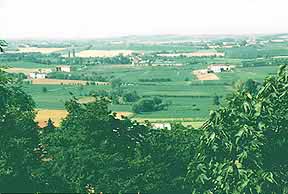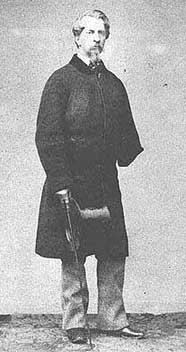
Philip
Kearny:
An
American soldier's gallant fight
in the Battle of Solferino
Information
contributed by William B. Styple
June
24, 1999 marks the 140th anniversary of the Battle of
Solferino—the most decisive battle of the Italian
Campaign in the Franco-Austrian War which would unify
Italy, set the stage for modern warfare, and result in
the formation of the International Red Cross. This key
world event also would recognize the undaunted American
soldier, Philip Kearny, again proving his bravery on
foreign soil amongst his French comrades.
 In April 1859, the
outbreak of the Franco-Austrian War found the army of
Napoleon III, Emperor of France, in alliance with the
army of Victor Emmanuel II of Piedmont-Sardinia (King of
Italy) in an attempt to oust Emperor Franz Joseph's
Austrians from northern Italy. Retired U.S. Army Major
Philip Kearny, then living in Paris at 15, avenue
Matignon, personally applied to the French emperor
for permission to join the Chasseurs d'Afrique in
the Italian Campaign. Kearny had served with the Chasseurs
as a U.S. military observer in Africa in 1840 and wished
to rejoin his old regiment. His request denied, Kearny
instead was given the distinguished honor of an
assignment on the staff of General Morris. Morris,
Kearny's former commander in Africa, had been chosen by
the emperor to lead the Cavalry Division of the Imperial
Guard. In April 1859, the
outbreak of the Franco-Austrian War found the army of
Napoleon III, Emperor of France, in alliance with the
army of Victor Emmanuel II of Piedmont-Sardinia (King of
Italy) in an attempt to oust Emperor Franz Joseph's
Austrians from northern Italy. Retired U.S. Army Major
Philip Kearny, then living in Paris at 15, avenue
Matignon, personally applied to the French emperor
for permission to join the Chasseurs d'Afrique in
the Italian Campaign. Kearny had served with the Chasseurs
as a U.S. military observer in Africa in 1840 and wished
to rejoin his old regiment. His request denied, Kearny
instead was given the distinguished honor of an
assignment on the staff of General Morris. Morris,
Kearny's former commander in Africa, had been chosen by
the emperor to lead the Cavalry Division of the Imperial
Guard.
 Dressed in uniform as a major of
the First Regiment, U.S. Dragoons, Philip Kearny left
Paris on May 12, 1859, the day after the departure of
Emperor Napoleon III. In a battle comprised of 270,000
men, Kearny fervently fought with the Chasseurs
for more than nine brutal hours. The bloodthirsty
soldiers savagely attacked their adversary, employing
bayonets and repeatedly shooting the wounded with new
guns that fired conical "minié balls"—the
spiral barrel of the rifle afforded greater accuracy.
Along with this new weaponry and ammunition, novel
tactics such as communication via telegraph and the
transportation of troops by rail would be
utilized—later to be seen in the Civil War. The
French Zouaves, who would perform heroic deeds during
this campaign, also would be discovered by Americans and
lionized—evidenced by the scores of Zouave regiments
that would fight in the Civil War, styled after their
French counterparts. (See the article about Duryée's Zouaves at the
Battle of Second Manassas.) Dressed in uniform as a major of
the First Regiment, U.S. Dragoons, Philip Kearny left
Paris on May 12, 1859, the day after the departure of
Emperor Napoleon III. In a battle comprised of 270,000
men, Kearny fervently fought with the Chasseurs
for more than nine brutal hours. The bloodthirsty
soldiers savagely attacked their adversary, employing
bayonets and repeatedly shooting the wounded with new
guns that fired conical "minié balls"—the
spiral barrel of the rifle afforded greater accuracy.
Along with this new weaponry and ammunition, novel
tactics such as communication via telegraph and the
transportation of troops by rail would be
utilized—later to be seen in the Civil War. The
French Zouaves, who would perform heroic deeds during
this campaign, also would be discovered by Americans and
lionized—evidenced by the scores of Zouave regiments
that would fight in the Civil War, styled after their
French counterparts. (See the article about Duryée's Zouaves at the
Battle of Second Manassas.)
In the aftermath of the Battle of Solferino, a total of
40,000 French, Austrian, Italian casualties littered the
countryside. From the horrors of this battle the
International Red Cross would be born, founded in 1864 by
Swiss businessman (Jean) Henri Dunant, eyewitness to the
slaughter. This organization would serve as a model for
the American Association of the Red Cross, established by
Clara Barton in 1881.
As for Philip Kearny, the great warrior arrived home two
days before the emperor's return on July 14th. Kearny
wrote of his battle experience to cousin John Watts
DePeyster:
Paris,
July 14, 1859
My
two months have been all that a Military Man would have
desired—a school of such grandeur as rarely occurs,
even here in the Old World—and the Drama has been
complete.
I have roamed about everywhere, and in the day of
Solferino, I was not only present with the line of our
cavalry skirmishers, (but) as well in every charge that
took place. That day I was mounted from six in the
morning till eleven at night—scarcely off my horse
even for a few minutes—depend on it, he was a good
one. The cavalry of the guard came up some sixteen miles
in full trot and rapid gallop to take our places, under
fire; for there was a gap we had to stop. The night
before the battle I had a miraculous escape, having been
inveigled by false guides into the midst of the Austrian
masses.
For
Kearny's superb conduct in the campaign—particularly
at Solferino—General Morris initiated the process
for France to recognize his services. On February 17,
1860, Emperor Napoleon III accorded Kearny the Cross of
the Legion d'Honneur (Legion of Honor), France's
highest military accolade. He would be the first American
to receive the Cross for military service.

The
village of Solferino is situated south of Lake Garda
between Milan and Verona in northern Italy. The Solferino
battlefield is located along the Brescia to Mantua
highway (N. 236), at a point 6.4 km southeast of
Castiglione delle Stiviere. There is an excellent museum
and memorial in the village of Solferino.
Above
right: A view of the area today in which the Battle of
Solferino was fought, photographed from the point where
the Austrians were positioned. Bottom left: Philip Kearny
in Paris, 1859.
Thanks
to Bill Styple for sharing this information and these
photos.

Index to Kearny's Pages
Back | Home
Copyright © 2001 - 2009 1st Dragoon's Civil War Site. All rights reserved.
Spider
Map Index
|

 In April 1859, the
outbreak of the Franco-Austrian War found the army of
Napoleon III, Emperor of France, in alliance with the
army of Victor Emmanuel II of Piedmont-Sardinia (King of
Italy) in an attempt to oust Emperor Franz Joseph's
Austrians from northern Italy. Retired U.S. Army Major
Philip Kearny, then living in Paris at 15, avenue
Matignon, personally applied to the French emperor
for permission to join the Chasseurs d'Afrique in
the Italian Campaign. Kearny had served with the Chasseurs
as a U.S. military observer in Africa in 1840 and wished
to rejoin his old regiment. His request denied, Kearny
instead was given the distinguished honor of an
assignment on the staff of General Morris. Morris,
Kearny's former commander in Africa, had been chosen by
the emperor to lead the Cavalry Division of the Imperial
Guard.
In April 1859, the
outbreak of the Franco-Austrian War found the army of
Napoleon III, Emperor of France, in alliance with the
army of Victor Emmanuel II of Piedmont-Sardinia (King of
Italy) in an attempt to oust Emperor Franz Joseph's
Austrians from northern Italy. Retired U.S. Army Major
Philip Kearny, then living in Paris at 15, avenue
Matignon, personally applied to the French emperor
for permission to join the Chasseurs d'Afrique in
the Italian Campaign. Kearny had served with the Chasseurs
as a U.S. military observer in Africa in 1840 and wished
to rejoin his old regiment. His request denied, Kearny
instead was given the distinguished honor of an
assignment on the staff of General Morris. Morris,
Kearny's former commander in Africa, had been chosen by
the emperor to lead the Cavalry Division of the Imperial
Guard. Dressed in uniform as a major of
the First Regiment, U.S. Dragoons, Philip Kearny left
Paris on May 12, 1859, the day after the departure of
Emperor Napoleon III. In a battle comprised of 270,000
men, Kearny fervently fought with the Chasseurs
for more than nine brutal hours. The bloodthirsty
soldiers savagely attacked their adversary, employing
bayonets and repeatedly shooting the wounded with new
guns that fired conical "minié balls"—the
spiral barrel of the rifle afforded greater accuracy.
Along with this new weaponry and ammunition, novel
tactics such as communication via telegraph and the
transportation of troops by rail would be
utilized—later to be seen in the Civil War. The
French Zouaves, who would perform heroic deeds during
this campaign, also would be discovered by Americans and
lionized—evidenced by the scores of Zouave regiments
that would fight in the Civil War, styled after their
French counterparts. (See the article about
Dressed in uniform as a major of
the First Regiment, U.S. Dragoons, Philip Kearny left
Paris on May 12, 1859, the day after the departure of
Emperor Napoleon III. In a battle comprised of 270,000
men, Kearny fervently fought with the Chasseurs
for more than nine brutal hours. The bloodthirsty
soldiers savagely attacked their adversary, employing
bayonets and repeatedly shooting the wounded with new
guns that fired conical "minié balls"—the
spiral barrel of the rifle afforded greater accuracy.
Along with this new weaponry and ammunition, novel
tactics such as communication via telegraph and the
transportation of troops by rail would be
utilized—later to be seen in the Civil War. The
French Zouaves, who would perform heroic deeds during
this campaign, also would be discovered by Americans and
lionized—evidenced by the scores of Zouave regiments
that would fight in the Civil War, styled after their
French counterparts. (See the article about